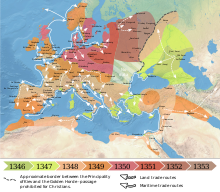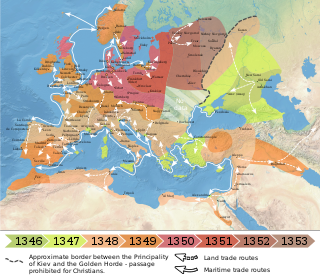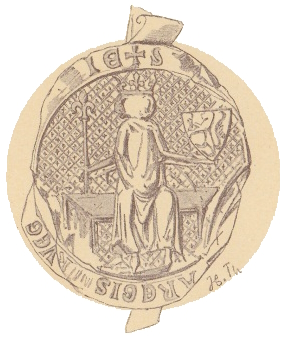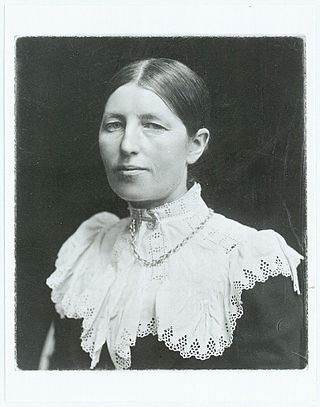
The Black Death was present in Denmark between 1348 and 1350. [1] The Black Death in Denmark is the least documented of all the Nordic countries, with the exception of Finland.

The Black Death was present in Denmark between 1348 and 1350. [1] The Black Death in Denmark is the least documented of all the Nordic countries, with the exception of Finland.
Prior to the Black Death, Denmark was the smallest of the Nordic countries, but it had the largest population, between 750.000 and one million people. [1]
Since the outbreak of the Black Death at the Crimea, it had reached Sicily by an Italian ship from the Crimea. After having spread across the Italian states, and from Italy to France from France to England, the plague reached Norway by a ship from England in 1349. In parallel, it was migrating North toward Denmark from Germany in the Holy Roman Empire. [1]
According to traditional legend, the Black Death came to Denmark when a Norwegian plague ship from England stranded on Vendsyssel on Northern Jylland after all of its crew had died. [1] The plague years for Denmark are traditionally attributed as 1348–1349, because the Zealand Chronicle recorded these years as the plague years. [1]
Whether the story of the plague ship is accurate is impossible to know, but the dates are not considered probable in modern research. [1] The Zealand Chronicle was written over ten years later and may have gotten the dates wrong, as they are not supported by other contemporary traces of the Black Death. [1] The Chronicle of the Archbishop of Lund as well as the Annales Scanici from Scania both date the year of the Black Death as 1350. [1] In contrast to the Zealand Chronicle they are contemporary, and it is not likely that the Black Death could have arrived to such a small country as Denmark in 1348 and took two years to progress through it. [1]
There are no contemporary witness statements from the Black Death in Denmark, but it is possible to trace the plague migration indirectly through donations, wills and occasional death lists, and according to these, the Black Death was present in Ribe on Jylland in July–October 1350, in Roskilde on Zealand in September–October, in Copenhagen in August–September and in Scania in July–December. [2]
The death toll is not possible to estimate. It is clear that Denmark experienced a demographic shock that took centuries to recover from. This is clearly visible from material during the years after the plague. [2]
Bishop Peter of Ribe mentions in a letter from 1352 that the income from agriculture had deteriorated and that this problem was not likely to become any better any time soon. [1] In 1354, the king pardoned an unusually large number of people from the death penalty with reference to the fact that the population had already diminished too much from the plague. [1]
In many parts of Denmark, the devastation is clear by deserted farms: in 1400, 34 of 48 farms under the Bröndum estate in Himmerland on Jylland was deserted, and in 1427 the region Hasle near Århus gave but a third of the income from agriculture that it had done prior to the Black Death. [1] Many churches were also abandoned during the same time. [2]
The diminishing population caused by the Black Death resulted in the introduction of serfdom in Denmark, the Vornedskab , which was introduced after the Black Death. [3]

The Black Death was a bubonic plague pandemic occurring in Europe from 1346 to 1353. One of the most fatal pandemics in human history, as many as 50 million people perished, perhaps 50% of Europe's 14th century population. Bubonic plague is caused by the bacterium Yersinia pestis and spread by fleas. One of the most significant events in European history, the Black Death had far-reaching population, economic, and cultural impacts. It was the beginning of the second plague pandemic. The plague created religious, social and economic upheavals, with profound effects on the course of European history.
The 1340s was a decade that began on 1 January 1340 and ended on 31 December 1349. It was in the midst of a period in human history often referred to as the Late Middle Ages in the Old World and the pre-Columbian era in the New World.

Haakon VI, also known as Håkan Magnusson, was King of Norway from 1343 until his death and King of Sweden between 1362 and 1364. He is sometimes known as Haakon Magnusson the Younger to distinguish him from his great-grandfather, Haakon V.

Valdemar IV Atterdag, or Waldemar was King of Denmark from 1340 to 1375. He is mostly known for his reunion of Denmark after the bankruptcy and mortgaging of the country to finance wars under previous rulers.

Anna Ancher was a Danish artist associated with the Skagen Painters, an artist colony on the northern point of Jylland, Denmark. She is considered to be one of Denmark's greatest visual artists.

The Black Death peaked in Europe between 1348 and 1350, with an estimated third of the continent's population ultimately succumbing to the disease. Often simply referred to as "The Plague", the Black Death had both immediate and long-term effects on human population across the world as one of the most devastating pandemics in human history, including a series of biological, social, economic, political and religious upheavals that had profound effects on the course of world history, especially European history. Symptoms of the Bubonic Plague included painful and enlarged or swollen lymph nodes, headaches, chills, fatigue, vomiting, and fevers, and within 3 to 5 days, 80% of the victims would be dead. Historians estimate that it reduced the total world population from 475 million to between 350 and 375 million. In most parts of Europe, it took nearly 80 years for population sizes to recover, and in some areas, it took more than 150 years.

The Black Death was one of the most devastating pandemics in human history, resulting in the deaths of an estimated 75 to 200 million people in Eurasia, and peaking in Eurasia from 1321 to 1353. Its migration followed the sea and land trading routes of the medieval world. This migration has been studied for centuries as an example of how the spread of contagious diseases is impacted by human society and economics.

The Black Death was a bubonic plague pandemic, which reached England in June 1348. It was the first and most severe manifestation of the second pandemic, caused by Yersinia pestis bacteria. The term Black Death was not used until the late 17th century.

The second plague pandemic was a major series of epidemics of plague that started with the Black Death, which reached medieval Europe in 1346 and killed up to half of the population of Eurasia in the next four years. It followed the first plague pandemic that began in the 6th century with the Plague of Justinian, but had ended in the 8th century. Although the plague died out in most places, it became endemic and recurred regularly. A series of major epidemics occurred in the late 17th century, and the disease recurred in some places until the late 18th century or the early 19th century. After this, a new strain of the bacterium gave rise to the third plague pandemic, which started in Asia around the mid-19th century.

The persecution of Jews during the Black Death consisted of a series of violent mass attacks and massacres. Jewish communities were often blamed for outbreaks of the Black Death in Europe. From 1348-1351, acts of violence were committed in Toulon, Barcelona, Erfurt, Basel, Frankfurt, Strasbourg and elsewhere. The persecutions led to a large migration of Jews to Jagiellonian Poland and the Grand Duchy of Lithuania. There are very few Jewish sources on Jewish massacres during the Plague.
A deserted farm in Norway, and other Nordic countries, is a farm that was left abandoned or unused for various reasons.

Diderich de Thurah (1704–1788) was a military cadet, a naval officer in the Royal Danish-Norwegian navy, shipbuilder and fabrikmester, artist and publisher.

The Black Death was present in Italy between 1347-1348. Sicily and the Italian Peninsula was the first area in then Catholic Western Europe to be reached by the bubonic plague pandemic known as the Black Death, which reached the region by an Italian ship from the Crimea which landed in Messina in Sicily in October 1347.

The Black Death was present in France between 1347-1352. The bubonic plague pandemic, known as the Black Death, reached France by ship from Italy to Marseille in November 1347, spread first through Southern France, and then continued outwards to Northern France.

The Black Death was present in the Holy Roman Empire between 1348 and 1351. The Holy Roman Empire, composed of today's Germany, Switzerland, Austria, Belgium and the Netherlands, was, geographically, the largest country in Europe at the time, and the pandemic lasted several years due to the size of the Empire.

The Black Death was present in Norway between 1349 and 1350. The Black Death in Norway is more documented than any other Nordic country, but the information is unbalanced and mainly focused on Western Norway.

The Black Death was present in Sweden between 1350 and 1351. It was a major catastrophe which was said to have killed a third of the population, and Sweden was not to recover fully for three hundred years.

The Black Death was present in Spain between 1348-1350. In the 14th-century, present-day Spain was composed of the crowns of Aragon and Castile, the Kingdom of Navarre, and the Emirate of Granada. In the countries on the Iberian Peninsula, the Black Death is well-documented and researched in Navarre and particularly in Aragon, but less documented in Castile, Portugal and Granada.

The Danish Civil Wars were a series of civil wars fought in the Kingdom of Denmark, first from 1131 to 1134 over the murder of Canute Lavard, then from 1139 to 1143, and finally a war of succession fought from 1146 to 1157, after the abdication of Eric III of Denmark, the first monarch in Danish history to have abdicated. The first phase of the war was fought between King Eric II of Denmark and King Niels joined by Magnus the Strong. The second phase of the war was fought between the son of Magnus the Strong, Canute V of Denmark, the son of Eric II of Denmark, Sweyn III of Denmark, and his cousin Valdemar I of Denmark, son of Canute Lavard. The civil wars marked an increase in the influence of the Holy Roman Empire in Denmark, and for a time after, Denmark was a vassal state of Emperor Frederick I. The war ended with the deaths of seven kings. Two of the kings, Olaf Haraldsen and Magnus the Strong, are not amongst the official Danish line of kings. The other kings are Niels I, Eric II, Eric III, Canute V and Sweyn III.

The Black Death was present in the Middle East between 1347 and 1349. The Black Death in the Middle East is described more closely in the Mamluk Sultanate, and to a lesser degree in Marinid Sultanate of Morocco, the Sultanate of Tunis, and the Emirate of Granada, while information of it in Iran and the Arabian Peninsula is lacking. The Black Death in Cairo, at the time the biggest city in the Mediterranean region, was one of the biggest documented demographic catastrophes during the Black Death.
You can help expand this article with text translated from the corresponding article in Swedish. (May 2020)Click [show] for important translation instructions.
|